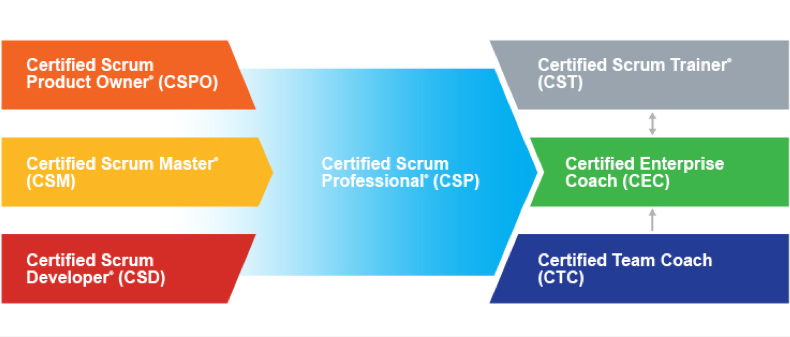SAFe-LPM mission - SAFe 5.1 Lean Portfolio Manager Updated: 2024

 |
 |
 |
 |
 |
 |
 |
 |
Scrum Portfolio mission
Other Scrum exams
PSM-I Professional Scrum Master I - 2023Scrum-PSM-II Professional Scrum Master II
Scrum-Master-Certified Scrum Master Certified
DASM Disciplined Agile Scrum Master
PAL-I Professional Agile Leadership (PAL-I)
PSK-I Professional Scrum with Kanban level I
PSPO-I Professional Scrum Product Owner I
PSPO-II Professional Scrum Product Owner II
SAFe-DevOps SAFe 5 DevOps Practitioner (SDP)
SAFe-Practitioner SAFe 5 Practitioner (SP)
SSM SAFe 5 Scrum Master (SSM)
SAFe-RTE Certified SAFe Release Train Engineer (RTE)
DASSM Disciplined Agile Senior Scrum Master
PAL-EBM Professional Agile Leadership - Evidence Based Management (PAL-EBM)
Scrum-PSD Professional Scrum Developer (PSD)
Scrum-PSD-I Professional Scrum Developer (PSD-I)
Scrum-SPS Scaled Professional Scrum (SPS)
SAFe-Agilist SAFe-Agilist
SAFe-LPM SAFe 5.1 Lean Portfolio Manager
ASSM SAFe 5 Advanced Scrum Master (SASM)
Which of the following LPM Events is focused on achieving and advancing the Portfolio Vision?
A. Business Agility Assessment
B. Portfolio Sync
C. Participatory Budgeting Forum
D. PI Planning
E. Strategic Portfolio Review
Answer: E
Explanation:
https://www.scaledagileframework.com/lean-portfolio-management/
Question: 46
Who has the overall responsibility to provide technical guidance for the long-term evolution of technologies and
platforms and larger nonfunctional requirements?
A. Solution Portfolio Management
B. APMO
C. Solution Train Engineer
D. The Enterprise Architect
E. Solution Architect/Engineer
Answer: D
Explanation:
https://www.scaledagileframework.com/lean-portfolio-management/
Question: 47
Metrics that measure internal or external activities, but do not correlate to desired business results are known as
$13$10
A. Fake Metrics
B. Vanity Metrics
C. Media Metrics
D. False Metrics
Answer: B
Explanation:
https://www.scaledagileframework.com/metrics/
Question: 48
Which of the following is a typical APMO role? (Choose two)
A. Establishing objective Metrics
B. Fosters more Agile contracts and leaner Supplier and Customer partnerships
C. Providing coaching and training to ART stakeholders and teams
D. Facilitating Value Stream identification workshops
E. Fosters decentralized Pl Planning and operational excellence
Answer: A,B,E
Explanation:
https://www.scaledagileframework.com/lean-portfolio-management/
Question: 49
Which of the following is a characteristic of the Lean-Agile Approach? (Choose two)
A. Strategic demand managed by portfolio Kanban; decentralized intake by value streams and ARTs
B. Big up-front, top down, annual planning and budgeting
C. Value Stream Budgets adjusted dynamically, participatory budgeting
D. Centralized, unlimited work intake, project overload
Answer: A,C
Explanation:
https://www.scaledagileframework.com/safe-lean-agile-principles/
Question: 50
After Analyzing the results of participatory budgets, all the following actions can take place except
A. Organizational changes are coordinated with functional business units
$13$10
B. LPM communicates the change to key leaders
C. Changes to the total portfolio budget are approved by LPM
D. Adjustment to Development value streams to align with new budgets as needed
Answer: C
Explanation:
https://www.scaledagileframework.com/participatory-budgeting/
Question: 51
A SAFe portfolio is a collection of
A. Product Solutions
B. Features
C. Epics
D. Capabilities
E. Development Value Streams
F. User Stories
Answer: E
Explanation:
https://www.scaledagileframework.com/lean-portfolio-management/
Question: 52
Solution Epics exist in which of the following Artifacts
A. Solution Kanban
B. Product Kanban
C. Portfolio Kanban
D. Program Kanban
Answer: A
Explanation:
https://www.scaledagileframework.com/lean-portfolio-management/
Question: 53
Who has the responsibility to ensure that Investments are spent on the right things at the right time?
A. LPM
$13$10
B. Epic Owner
C. Business Owners
D. Product Management
E. Product Owner
F. Solution Management
Answer: C
Explanation:
https://www.scaledagileframework.com/safe-lean-agile-principles/
Question: 54
Portfolio Epics sometimes may be split into: (Choose three)
A. Story points
B. Features
C. Program Epics
D. Solution Epics
E. Portfolio level Initiatives
Answer: A,B,C,D
Explanation:
https://www.scaledagileframework.com/epic/
Question: 55
Which of the following does not reflect a Fixed Mindset? (Choose two)
A. My abilities are unchanging
B. I do not like to be challenged
C. My effort and attitude determine my abilities
D. Failure is an opportunity to grow
Answer: A,C,D
Explanation:
https://www.scaledagileframework.com/lean-agile-mindset/
Question: 56
Which of the following is not true about the traditional budgeting model?
$13$10
A. Everyone is assigned to 100% capacity, often to multiple projects.
B. Teams make better fine-grained decisions when needed too early in the cone of uncertainty
C. Temporary team assignments hinders learning, engagement, and overall performanc
D. Focus is on individual skills
Answer: B
Explanation:
https://www.scaledagileframework.com/lean-budgets/
Question: 57
Which of the following are LACE team distribution models? (Choose three)
A. Hub-and-spoke
B. Decentralized
C. Centralized
D. Value streams
E. Network
Answer: A,B,C
Explanation:
https://www.scaledagileframework.com/lace/
Question: 58
In a 3 years portfolio roadmap, the First year is typically planned in:
A. Months
B. 6 Month increment
C. Quarters
D. Bi-monthly
Answer: C
Explanation:
https://www.scaledagileframework.com/roadmap/
Question: 59
Which if the following portfolio Kanban states requires active collaboration between Business owners, System and
solution Architects/engineers, and Agile teams?
$13$10
A. Analyzing
B. Funnel
C. Reviewing
D. Implementing Preservers
E. Portfolio Backlog
F. Implementing MVP
Answer: A
Explanation:
https://www.scaledagileframework.com/portfolio-kanban/
Question: 60
In a SAFe Managed investment contract , who is responsible for defining the preliminary scope and feasibility
A. It is a shared responsibility
B. The Supplier
C. The Customer
Answer: B
Explanation:
https://www.scaledagileframework.com/agile-contracts/
$13$10
Editorial Note: We earn a commission from partner links on Forbes Advisor. Commissions do not affect our editors' opinions or evaluations.
Scrum is a framework that uses agile methodology to accomplish product development through a series of iterations. Scrum teams work within this framework to address complicated issues as they create products to meet customers’ needs.
Scrum masters and scrum product owners both work in the product development process. While the two roles are related, if you compare scrum master vs. product owner positions, you’ll notice several differences as well. This article discusses scrum master vs. product owners and the responsibilities these workers have in developing products using the scrum framework.
What Is a Scrum Master?
A scrum master is responsible for leading scrum teams as they work to effectively develop a product. Scrum masters guide scrum teams as they operate within the scrum framework, helping to make sure each increment of product development is completed smoothly.
Scrum Master Role and Responsibilities
Scrum masters are responsible for managing scrum processes in agile methodology. Some of their typical responsibilities are laid out below.
- Scrum masters guide and coach scrum teams by leading daily scrum meetings, planning and managing sprints and handling other scrum events.
- Scrum masters ensure that scrum team members follow scrum principles as they work in sprints to reach their goals.
- They help product owners prepare product backlogs for sprints.
- They maintain communication with development team members to address any challenges or obstacles that may interfere with completing the project. They then work with scrum teams to meet these challenges and remove obstacles.
Requirements to Become a Scrum Master
If you want to become a scrum master, you must first enroll in a scrum master certification course. Completing scrum master training demonstrates that you have learned to guide scrum teams as they work toward specific goals. It also prepares you to pass a certification exam.
Scrum master certification requirements and costs vary depending on which provider you choose. Most programs cost between $200 and $1,995 for training courses. Many programs include the exam fees in their total scrum master certification cost.
A few organizations offer different types of scrum master training. As you look into various options, make sure to choose one that prepares you for a scrum master certification rather than one that just gives you a quick overview of scrum.
If you’re not sure if being a scrum master should be part of your career path, there are plenty of free scrum master certification training options available. These are typically abbreviated or trial versions of longer training programs, designed to teach you some foundational scrum principles. A free option may provide you with the information you need to decide whether completing a full scrum master certification program is for you.
Benefits of Working as a Scrum Master
If you enjoy collaborating with teams within the scrum framework, working as a scrum master can be a great way to further your career. Earning a scrum master certification qualifies you to work as a certified scrum master, which comes with many benefits.
Higher Earning Power
According to a salary survey by the Scrum Alliance, scrum masters typically earn about $7,000 more than scrum team members.
Becoming a certified scrum master can boost workers’ earnings even more; scrum managers earn about $113,000 per year, while certified workers earn an average of $122,000.
Career Advancement
Earning your scrum master certification opens new doors by building your advanced knowledge of the scrum framework and agile principles. As a scrum master, you’re qualified to move into a leadership role as you guide scrum teams toward common goals and ensure that each step of the process is executed properly.
Comprehensive Scrum Knowledge
Scrum masters must have a deep understanding of scrum artifacts, such as sprint backlogs and burndown charts. Scrum masters use this knowledge to improve team efficiency, reduce misunderstandings and help scrum teams meet their goals successfully.
What Is a Product Owner?
A product owner creates the vision for a product and communicates with development teams and customers to make sure that product development occurs according to plan. Within the scrum framework, a product owner manages a product backlog to ensure that tasks are prioritized properly for the scrum team.
Product Owner Role and Responsibilities
Product owners fill a visionary role for a product. They are also frontline contacts with their organizations’ customers. Product owner responsibilities include the following:
- Maintain the product backlog and ensure that the Scrum team works on each iteration that the backlog contains according to plan. A product backlog is the collection of tasks that make up a product.
- Develop a vision for a product and ensure that the development team follows a set plan to create a product that aligns with that vision.
- Serve as the main point of contact with customers, and maintain customer satisfaction.
- Communicate with various teams, including scrum teams and development teams, to make sure they are working toward and achieving the product goals.
- Stay updated on market trends to help development teams design and develop products.
- Establish deadlines and completion dates, create product backlogs for scrum teams and set priorities for product development.
Requirements to Become a Product Owner
If you want to become a scrum product owner, you must learn everything you can about the agile framework. As a product owner, you should have a thorough understanding of the scrum framework, including its artifacts and events. You can learn these aspects by participating in training programs.
To become a certified product owner, you must complete a certification program. These programs typically involve a course lasting at least two days. They may or may not have exam requirements, depending on the option you choose. Some options require exams but not specific training.
Benefits of Working as a Product Owner
If you want to play an essential role in providing the vision and leadership that enables companies to increase the value of their products, then becoming a product owner may be a fulfilling career option for you. There are many benefits to earning a product owner certification, including increased earning power.
Excellent Earning Potential
Scrum product owners earn an average of $129,000 per year, while those with certifications earn about $144,000 annually. Experience plays a large role in salary for product owners as well. With four to six years of scrum-related work experience, workers’ average annual salary increased by about $15,000.
Growth in Leadership Skills
Becoming a product owner requires a great deal of responsibility and leadership. As a product owner, you are the face of a product, and you are ultimately responsible for its successful completion. This includes working with clients to communicate their needs to development teams. The product owner role requires you to use your leadership skills and insights to help bring a product from the drawing board to fruition.
Potential for Career Advancement
Earning a product owner certification can make you eligible to move forward with additional certifications. More advanced agile certifications often require candidates to become certified product owners first.
What Are the Similarities Between Scrum Master and Product Owner?
Agile methodology frameworks like scrum are used among many types of companies in industries including construction, software manufacturing, production and aerospace.
You can find both scrum masters and product owners working within the scrum framework. Both scrum masters and product owners must fully understand scrum principles, and both roles are essential to effective product development within scrum teams.
What Are the Differences Between Scrum Master and Product Owner?
While scrum masters and product owners are both involved in product development within the scrum framework, differences exist between the two roles. Scrum masters are responsible for guiding scrum teams through each step of the product development process. They work hands-on within scrum teams to reach the goals needed for a successful product.
Product owners take on more of a visionary role. Rather than working directly with scrum teams on specific goals, these professionals communicate directly with scrum masters, customers and other stakeholders to make sure each product aligns with its original vision and meets the customer’s needs.
Which One is Right for You?
If you’re not sure whether to pursue certification as a Scrum Master or a Product Owner, you should carefully consider the many aspects of each role.
If you enjoy working with others to create a vision for a product and set deadlines and plans for product creation, you might thrive as a Product Owner. If you prefer to guide teams as they work with iterative tasks, evaluate each step and refine processes to create a product, Scrum Master may suit you better.
The Mission, the first program in KQED's series Neighborhoods: The Hidden Cities of San Francisco, premiered in December, 1994. The one-hour documentary, which traces the rich history of San Francisco's Mission District, has received three local Emmy nominations and a Bronze Apple from the National Educational Film and Video Festival.
There are no VHS tapes or DVDs available for The Mission from KQED. You may want to check www.eBay.com or www.amazon.com to see if there are any used VHS tapes.
Neighborhoods: The Hidden Cities of San Francisco is an ongoing television series designed to explore the rich history of this unique American city. From the earliest Native American villages of the Mission District to the ethnic enclaves of Chinatown and North Beach, each program will reveal the city as a mosaic of communities with interconnecting pasts. Viewers drawn to the fascinating stories will discover meaningful connections between their daily lives and the deeper histories we share. As we continue to grow in our appreciation of diverse cultures, Neighborhoods will give viewers a crucial sense of the traditions that link us, not only to the past, but to one another.
![]()
Take me to the Neighborhoods Menu page

Agile processes are focused on the rapid and repeatable delivery of products or projects. Today, more and more companies across industries—including IT, manufacturing, marketing and communications, healthcare, and construction—are implementing Agile methodologies and development practices to help improve project management skills and stay competitive. For Agile to be effective and to maximize business value, they depend on continuous iterative planning and feedback loops—and the Scrum process allows you to do so quickly and effectively.
Traditional waterfall project management assumes you will map everything from the beginning through one streamlined process. Agile reflects the changing nature of requirements and feedback throughout the process of project delivery. It is a methodology where you apply an iterative approach to project management. Instead of delivering a final product to a client at an end deadline, you are constantly consulting with the client and stakeholders throughout smaller deliveries and feedback sessions or “sprints.” Living up to its name, Agile project management allows you to be nimble and responsive to the changing needs of your client and your team.
Scrum is an implementation of the Agile methodology. A Scrum meeting is focused on how you organize team roles, update client feedback and the latest changes in requirements. During this process, teams regroup to make sure the project is on task, on time and on budget. During Scrum meetings, project leaders and teams identify the steps, resources and personnel needed to complete a task.
Why Use Agile Methodology & Scrum Processes?
-
Faster results
Agile allows you faster product releases and ability to adapt to customer response and client feedback. Agile has a greater ability to guarantee project completion on time and on budget. Rather than responding to bulk feedback or a change in client needs by the time of final delivery, Agile helps your team to adapt and deliver throughout the development process.
-
Improved teamwork and communication
The Agile methodology places a value on person-to-person interaction and is dependent on open, regular communication. In an Agile Scrum project, teams come together on a daily basis to work through changes and share updates on each team member’s progress.
-
Risk and waste aversion
The frequent touch points throughout the Agile Scrum process ensures that client needs, even as they evolve, are met while still ensuring that project team time and resources are optimized.
FAST FACTS ABOUT AGILE SCRUM
- 71 percent of companies are using Agile Scrum to improve efficiency and increased product-to-market timeframes
- Agile is a methodology and Scrum is a process within Agile
- Agile frameworks help companies accelerate time to market, increase productivity and respond to changes in priorities
- Agile Scrum is growing beyond IT and taking hold in diverse industries, such as:
- Manufacturing
- Media and communications
- Healthcare
- Construction and infrastructure
Ready to explore Agile Scrum training?
Drexel’s Goodwin College of Professional Studies offers professional pathways and courses to get up to speed about Agile Scrum. You can take two-day courses, ranging from beginner to advanced levels here on campus. Or, you can explore a professional skill track in Agile project management that includes on-campus courses and online essential skill training through The Skills Hub.
If your company is using waterfall and exploring adopting Agile, consider about Agile project management with Scrum training for your employees. Talk to us about getting a complimentary training skills gap analysis and our multiple employee discount.
I’m the cofounder of ROCKETECH, a software development company that converts business to digital form for customers.
If you do a little research about Scrum, you might find diametrically opposed opinions—either it’s the best thing that can happen to an IT business, or it’s a waste of time. Many startup founders are convinced that Scrum doesn’t work. I sometimes hear that they don’t like that employees become heavily involved in the process and product. The most common reason I’ve found, however, is that new businesses don’t know how to use it.
For those who are not familiar, Scrum is a lightweight framework designed for effective project management. It revolves around the agile approach to development and implies breaking the project into smaller iterations. Each iteration aims to create value for the user. The system of roles, events, artifacts and, essentially, rules maximizes the team’s efficiency and ensures process transparency.
A typical misconception is that Scrum is designed for corporations, enterprise-level projects and endless development. In my experience, Scrum actually works best for small teams in dynamic environments. If you follow the framework thoroughly, it can help ensure effective release management.
A Way To Better Planning
Scrum is an effective tool to help analyze your team’s efficiency. It allows you to finetune flexible release planning, which is often the biggest challenge in a project. Many companies immediately try to build a vertically (rather than horizontally) integrated organization. It leads to efficiency loss, lower development speed and problems with project estimation.
In such organizational environments, development teams often evaluate tasks in hours. However, this approach relies on an ideal working day with no emergencies, coffee breaks and requirements change. That’s where higher risk estimation comes from—the team must assume all possible (and even seemingly impossible) risks.
Hourly estimates might work in simple projects like making designs. But software development is a complex and continuous process with ever-changing tasks. To facilitate this complexity, industry thought leaders created the story point estimation technique. Its goal is to make people reach a consensus through arguing, agreeing and exchanging experiences. It helps people understand the shared goal and see the most effective way toward it.
Moreover, precise release planning allows you to estimate and distribute the workload. You understand how many features the team can release each sprint and how fast further sprints will be. That’s how the speed increases: The team generates its accumulated potential with every sprint.
Adaptive At The Core
Many startups try to build a static product and choose the respective approach. They spend months (if not years) on research looking for that one idea that will make them a fortune. When they get to the development part, there are dozens of tasks programmers and designers must complete within strict timeframes. As a result, the project breaks down into layers; it’s as if the backend and frontend developers, designers and QAs all work on different projects.
But startups in realistic environments are never static. Neither are market needs. If you want to launch the product customers need, you must adapt to these rapid changes and flashy trends by adjusting the tasks repeatedly. And being a highly adaptive framework, Scrum evens it out. In a Scrum team, everyone creates the same product (rather than separate parts) and is motivated to release a feature every sprint.
What is more, it’s a very lightweight framework. It doesn’t give you answers to all questions and detailed instructions for each team member. Scrum is intentionally incomplete and thus a universal methodology that can accommodate specific scenarios, projects and requirements.
Some companies misinterpret the incompleteness concept and try reinventing the wheel by taking only selected parts of the framework. It often ends in using restricted Scrum, also known as ScrumBut. Although the idea “We use Scrum, but…” is understandable in theory, I find that the model only works when applied from A to Z.
Faster Time To Market
In today’s unstable market conditions, time to market becomes the main driving force behind the product launch. All you do should concentrate on a feature, while the latter focuses on the market. The monolith approach is the reason why many startups fail. It frequently leads to the situation where nobody needs the product, no matter how perfect it is.
In Scrum, the team develops features for market testing. That’s how Scrum helps founders find answers. The faster they can test a hypothesis, the sooner they get user feedback. It helps ready-to-adapt businesses discover customer pain points that eventually generate revenues.
A guaranteed dead end is testing ideas after launching a full-fledged product. Often, founders get carried away by focusing on beautiful designs or implementing features that exist solely in their imagination. They spent a long time going in the wrong direction only to realize they required a completely different product initially.
The sad truth is they will eventually get invaluable feedback from the market, but it’s usually too late. In such situations, founders end up spending more money, time and effort to start over and build the product people need.
Using Scrum first for hypothesis testing will instantly show that users don’t really care how imperfect the design is if the product solves their problem. This way, already at the MVP stage, startups can collect the growth metrics vital for further big investments.
Ideas Always Evolve
No idea will ever stay the same. It is the beauty and pain of the process. And Scrum allows startups to adapt to rapidly changing conditions and market requirements. The most recent history of the global pandemic and military conflicts has shown that long-term business plans no longer work.
Ken Schwaber, the co-developer of Scrum, described the framework as a model far beyond simply building software functionality. Metaphorically, we live from sprint to sprint, trying to adjust to the surroundings and new realities. And we need to repeat it all over again to get a result. That’s the underlying principle of Scrum.
Forbes Business Council is the foremost growth and networking organization for business owners and leaders. Do I qualify?
Scrum is a widely used Agile project management framework. As one of the most popular Agile methodologies, Scrum is commonly used by software development teams; however, it can be applied to any industry. Organizations that use the Scrum framework benefit from higher productivity, improved product quality, reduced risk and happier team members.
The Scrum framework requires three key team roles, including the Product Owner, the Scrum Master and the development team. The certified Product Owner and Scrum Master roles are often sought after by aspiring Scrum leaders who wish to lead teams to project success. And if you’re one of them, you must consider obtaining a Scrum certification.
There are many Scrum certifications out there to choose from, depending on your goals. Here, we break down some of the best certifications available to you.
Why earn a Scrum certification?
There are many benefits to earning a Scrum certification. First, certification provides the knowledge you need to lead teams through successful initiatives. In addition, many organizations looking to take advantage of Scrum are searching for certified Scrum Masters and Product Owners to fill open roles. Obtaining a certification can help you remain competitive in your job search or solidify your place in your current organization. You will also learn how to apply the Scrum techniques to project management tools such as Kanban boards.
Agile Scrum Certification by Master of Project Academy: Best for easy-paced training
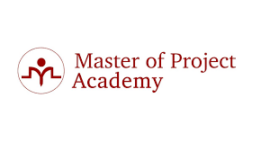
The Agile Scrum Certification by Master of Project Academy is designed to teach Agile and Scrum project management foundation. The course is designed to be easy-paced, so you can complete the training even if you are working full-time.
Prerequisites
There are no specific qualifications needed; however, it is recommended that the candidates have some knowledge of and experience with Scrum and Agile methodologies.
Key skills taught
- Theoretical Agile and Scrum concepts explained in real-world examples.
- Scrum events, frameworks and artifacts.
- Agile manifesto and Scrum theory.
- Common misconceptions about Agile and Scrum.
Key differentiators
- 100% online course.
- Easy-paced training.
Duration of training and exam
The training is 10 hours long and consists of 150+ practice questions to help prepare for certification exams. There is no exam in this course, though there is a sample Agile Scrum certification exam.
Cost of training
You can choose from different types of subscriptions ranging from $67 for a monthly subscription to $527 for lifetime access.
Certified ScrumMaster (CSM) by Scrum Alliance: Best for professionals leading Scrum teams
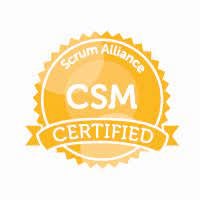
The Certified ScrumMaster (CSM) certification is considered to be the gold standard. This certification was developed for those new to Agile as well as the more seasoned, including software engineers and project managers.
During the certification course, you’ll learn everything there is to know about the Scrum framework, including Scrum theory and how to plan sprints. Once you complete the CSM certification, additional courses are available such as the Advanced Certified ScrumMaster certification course.
Prerequisites
CSM is an introductory course for aspiring Scrum Masters and individuals that are already leading Scrum teams. Therefore, there are no eligibility criteria or experience required for CSM certification.
Key skills taught
- Application of Scrum framework and roles for various use cases.
- Lessons on Agile principles, estimations and metrics.
- Importance of continuous improvement.
- Skills on how to facilitate discussions, events and meetings.
- Improvement of leadership and influence of organizational change.
Key differentiators
- The program is focused on the Scrum framework.
- This certification can be a prerequisite for certain Scrum Master jobs.
Duration of training and exam
The Certified ScrumMaster (CSM) by Scrum Alliance training which runs for two days is estimated to be around 16 hours. The duration of the certification exam is two hours. The format of the exam is 50 multiple-choice questions.
Cost of training and exam
The cost of Certified ScrumMaster (CSM) by Scrum Alliance certification is between $405 and $695, depending on date, time, and instructor. There is also a $25 charge for each additional attempt at the exam.
Professional Scrum Master (PSM) by Scrum.org: Best for a deep understanding of Scrum principles
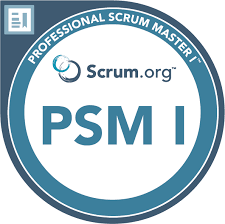
Scrum.org offers three levels of Professional Scrum Master: PSM I, PSM II and PSM III. The Professional Scrum Master certification solidifies your knowledge of the Scrum framework and how it’s used. While the Professional Scrum Master I certification is perfect for Scrum beginners, PSM II and PSM III are best for those with more advanced skills.
Scrum.org offers the Professional Scrum Master certification exams to professionals with or without previous Scrum training. However, they also offer training courses for those just getting started with Scrum. PSM I is required to obtain the PSM II and III certifications.
Prerequisites
There are no formal eligibility criteria or required skills to obtain the Professional Scrum Master (PSM) by Scrum.org. However, you must have completed the previous level of PSM to progress to the next. For example, to get the PSM III certification, you must have completed PSM I and PSM II.
Key skills taught
The skills taught in this certification depend on the level of the program:
- PSM 1: Basic understanding of Scrum framework, development teams and management of products.
- PSM II: Managing technical risk and developing an understanding of organizational design and culture.
- PSM III: Deep understanding and application of Scrum practices.
Key differentiators
- Three distinct levels of Scrum training and certification.
- Deep understanding of Scrum framework.
Duration of training and exam
The training lasts for two days and goes for eight hours each day for a total of 16 hours of training. The format and duration of the exam depend on the level of the program. The duration varies from 60 to 150 minutes, and the number of questions varies from 30 to 150.
Cost of training and exam
The cost of training depends on the level of the program. It varies from $150 to $500.
SAFe Scrum Master (SSM) by Scaled Agile: Best for individuals looking to coach or lead Agile teams
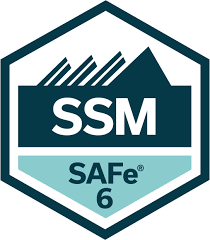
The Scaled Agile Framework (SAFe) is a leading framework for scaling Agile according to Gartner. SAFe is provided through Scaled Agile, which also provides the SAFe Scrum Master (SSM) certification for SAFe-specific organizations.
During the training course, you’ll learn how to lead Agile teams in a SAFe environment, how to conduct iteration planning and more. Once you complete the training program, you’ll be prepared to take the SAFe Scrum Master certification exam, which is best for those with intermediate-level skills.
Prerequisites
There is no formal requirement for the SAFe Scrum Master (SSM) by Scaled Agile; however, it is recommended that the candidate has basic Scrum and Agile experience.
Key skills taught
- Empower and lead an Agile team.
- Help teams plan and execute their work.
- Coach Agile teams.
- Implement DevOps for continuous flow
- Facilitate Agile events, discussions and meetings.
Key differentiators
- Emphasis on Lean-Agile mindset.
- Focus on Scaled Agile Framework (SAFe).
- Testing of candidates on their ability to apply Scrum principles to real-world situations.
Duration of training and exam
The training takes place over the course of two days, lasting eight hours each day for a total of 16 hours of training. The exam for SAFe Scrum Master (SSM) by Scaled Agile consists of 45 multiple-choice questions, and the duration is 90 minutes.
Cost of training
The cost of training depends on several factors, including location and mode of delivery. You can expect the SAFe Scrum Master (SSM) by Scaled Agile training and certification to cost between $500 to $2000.
Certified Scrum Product Owner (CSPO) by Scrum Alliance: Best for Agile Product Owners
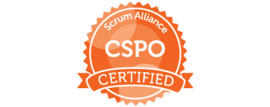
The Certified Scrum Product Owner (CSPO) certification is for those wanting to learn how to bring new products to life. During this course, Product Owners, project managers and other Agile team members can dive deeper into the Scrum framework as well as the principles required for success.
The CSPO certification is one of the most popular options for Product Owners simply due to its benefits. For example, according to a survey completed by Indeed, 39% of the CSPO-certified Product Owners stated that the certification helped them achieve a higher salary.
Prerequisites
The Certified Scrum Product Owner (CSPO) by Scrum Alliance does not have specific required skills.
Key skills taught
- Hands-on training for creating product vision.
- Innovative methods to generate product value.
- Product backlog management.
- Agile planning and estimation.
- Release management.
Key differentiators
- Ideally suited for existing Product Owners.
- Does not have an exam.
- Practical and hands-on learning.
Duration of training and exam
There is no exam required to earn a Certified Scrum Product Owner (CSPO) certification.
Cost of training
Expect to spend around $399-$780 for training and certification for the Certified Scrum Product Owner (CSPO) by Scrum Alliance. There is also a $100 certification fee paid upon the successful completion of the program.
Professional Scrum Product Owner (PSPO) by Scrum.org: Best for introduction to Product Owner role in Scrum environment
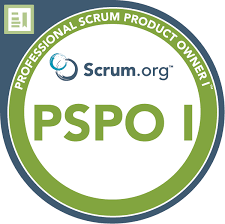
The Professional Scrum Product Owner (PSPO) certification is similar to the PSM certification as there are three distinct certifications depending on your skill level: PSPO I, PSPO II and PSPO III.
This certification is built on the professional Scrum competencies, including understanding the Scrum framework, developing teams and managing products from plan to launch. PSPO I is required to be able to obtain the PSPO II and III certifications.
Prerequisites
There is no specific eligibility criteria or required skills for the Professional Scrum Product Owner certification. However, each level of the PSPO builds on the previous level, so you will need to pass each level to proceed.
Key skills taught
- Deployment of Scrum framework.
- Value-driven deployment.
- Creation and management of product backlog.
- Collaboration with stakeholders.
Key differentiators
- Focus on the Product Owner role with emphasis on real-world application.
- Continuous learning and improvement and a clear progressive path with three levels of certification.
Duration of training and exam
The entry-level PSPO I has two days or 16 hours of live training. The duration and format of the exam depend on the level of certification. The exam for the PSPO ranges from 60 minutes to 90 minutes, depending on the certification level.
Cost of training
The Professional Scrum Product Owner certifications are typically priced between $1000 to $1500. You also have a test attempt fee in the range of $200 to $500, though the training course includes a free attempt at the exam.
SAFe Product Owner/Manager (POPM) by Scaled Agile: Best for a combination of Product Manager and Product Owner training
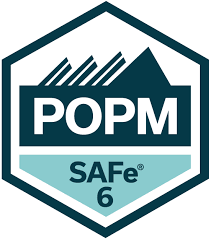
The SAFe Product Owner/Manager (POPM) certification is specifically for Product Owners who wish to learn how to build products using the Scaled Agile Framework. Inside the course, you’ll learn how to thrive in your role as a Product Owner, how to test projects and how to collaborate with others on your Scrum team.
Prerequisites
Candidates for the SAFe Product Owner/Manager must have attended a SAFe PO/PM or LEADIng SAFe course. If they don’t fulfill this requirement, then they must have a minimum of one year of experience in a PO/PM role in a SAFe environment.
Key skills taught
- Comprehensive understanding of product development process.
- Preparation for the roles of POs and PMs.
- Training on how to design, build, test and deliver products with high quality and maximum productivity.
- Lessons on how to prepare for and lead PI Planning.
- Collaboration and communication with cross-functional teams.
Key differentiators
- Combination of two key roles: Product Manager and Product Owner.
- Focus on a Lean-Agile mindset.
Duration of training and exam
The training duration for this certification is two days. The duration of the SAFe Product Owner/Manager (POPM) exam is 90 minutes. It consists of 45 multiple-choice questions.
Cost of training
The cost of the SAFe Product Owner/Manager (POPM) ranges from $1000 to $1500 depending on the instructor, location, study materials and other factors.
Advanced Certified ScrumMaster (A-CSM): Best for advanced training for Scrum professionals
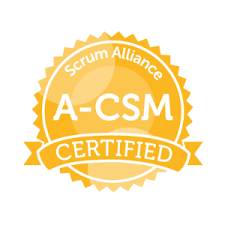
The Advanced Certified ScrumMaster (A-CSM) is an advanced and immersive course for the Scrum Master role. The program is designed to use real-world examples and encourage a collaborative learning experience. The course teaches attendees practical tools and techniques that can be applied to their work.
Prerequisites
The candidate must meet all the following requirements for the Advanced Certified ScrumMaster:
- Active CSM certification.
- At least one year of experience as a Scrum Master.
- Completion of all pre-course work as deemed necessary by the instructor.
Key skills taught
- Learn how to explain Agile and Lean methods to your team.
- Help your organization adopt Scrum and Lean frameworks.
- Facilitate dialogue between Product Owner, customers, executives and other stakeholders.
Key differentiators
- Focus on advanced skills for Scrum Masters.
- Practical application with real-world examples.
- Customized learning with a variety of Scrum topics.
Duration of training and exam
The training takes place over the course of two days, lasting eight hours each day for a total of 16 hours of training. There is no exam for the Advanced Certified ScrumMaster (A-CSM).
Cost of training
The cost of training for the Advanced Certified ScrumMaster (A-CSM) varies from $1000 to $2000 depending on availability, location, instructor and other factors.
Scrum Master by Scrum Inc. (RSM) Certification: Best for learning practical Scrum skills
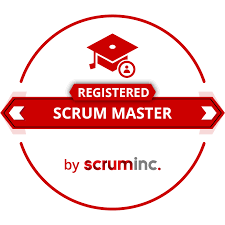
The Scrum Master by Scrum Inc. (RSM) is developed by the co-creator of Dr. Jeff Sutherland. The course is designed to be highly interactive and includes a variety of exercises and games. Attendees will get to experience the Scrum Master role first-hand. This includes how to create a product backlog and manage a burndown chart.
Required skills
There are no prerequisites or specific eligibility criteria for the Scrum Master by Scrum Inc (RSM).
Key skills taught
- How to lead teams in any industry and environment as a Scrum Master.
- Experience with Serum frame and Agile principles.
- How to facilitate, coach and build a Scrum team.
- Training on organizational design.
- Preparation for Lean thinking.
Key differentiators
- Focus on practical skills.
- Customized learning experience.
- Real-world experience.
Duration of training and exam
The Scrum Master by Scrum Inc. (RSM) is a two-day course including training and certification. There is no separate exam for this certification. However, the attendees must demonstrate their understanding and knowledge of Scrum and their ability to apply their learning to their work.
Cost of training
The Scrum Master by Scrum Inc. (RSM) certification costs range from $1200 to $2000.
Key benefits of scrum certifications in project management
Scrum certifications provide attendees with the knowledge, hands-on experience and confidence to apply Scrum techniques and frameworks to their work. Here are some of the key benefits of scrum certifications in project management:
Solid knowledge base
With Scrum certification, you get a solid knowledge base of core Scrum principles and best practices. This helps you to guide teams and remove impediments in various situations. This can help you boost your team’s effectiveness.
Improved risk-assessment skills
One of the major goals in project management is to anticipate problems and events before they occur. With Scrum certification, you will strengthen your risk-assessment skills. This will help you eliminate any impediments or bottlenecks that threaten to stall your project.
Career advancement
Whether you are a project manager, IT professional or business executive, you can prepare yourself for more career opportunities with Scrum certifications. It can also increase your earning potential and make your résumé stand out.
Better project outcomes
Scrum certifications teach you skills and tools that enable you to improve project outcomes by applying Scrum learning. This is achieved through better management of processes, enhanced collaboration and communication, and increased productivity.
How do I choose the best scrum certification?
As mentioned above, getting Scrum certifications in project management offers several benefits. However, you need to choose the right program to fully benefit from Scrum certification. Fortunately, there is a variety of certifications to choose from. To pick the best Scrum certification for project management, you need to evaluate your current needs, experience level and future goals.
If you are new to the Scrum methodology and want an introduction to the framework, you will be better suited to choose a basic certification program. On the other hand, if you already have experience with Scrum, you can choose a more advanced certification program. There are some certifications that offer multiple levels of training, providing a clear progressive path from basic to advanced level.
Review methodology
This list of best Scrum certifications was compiled through extensive research and analysis of several certifications. We looked at the different parameters, including the usefulness of the certification and skills taught in the program.
Agile scrum methodology is used by companies of all sizes for its ability to provide high-end collaboration and efficiency for project-based work. Agile and scrum are two different methods and can be used separately; however, their combined benefits make the agile scrum methodology the most popular use of agile. Here’s the complete guide to agile scrum methodology.
Agile and scrum can be used separately, but their combined benefits make the methodology popular.
How does agile scrum work?
Agile scrum methodology is the combination of the agile philosophy and the scrum framework. Agile means “incremental, allowing teams to develop projects in small increments. Scrum is one of the many types of agile methodology, known for breaking projects down into sizable chunks called “sprints.” Agile scrum methodology is good for businesses that need to finish specific projects quickly.
Agile scrum methodology is a project management system that relies on incremental development. Each iteration consists of two- to four-week sprints, where the goal of each sprint is to build the most important features first and come out with a potentially deliverable product. More features are built into the product in subsequent sprints and are adjusted based on stakeholder and customer feedback between sprints.
Whereas other project management methods emphasize building an entire product in one operation from start to finish, agile scrum methodology focuses on delivering several iterations of a product to provide stakeholders with the highest business value in the least amount of time.
Agile scrum methodology has several benefits. First, it encourages products to be built faster, since each set of goals must be completed within each sprint’s time frame. It also requires frequent planning and goal setting, which helps the scrum team focus on the current sprint’s objectives and increase productivity.
What is agile?
Agile is a process that allows a team to more efficiently manage a project by breaking it down into several stages, each of which allows for consistent collaboration with stakeholders to promote steady improvements at every stage.
Agile lets a team manage a project more efficiently by breaking it down into several stages.
What are the values of agile?
Agile was first described in the Agile Manifesto in 2000 by a group of developers who sought out a new method of writing software. The manifesto cites four values:
- Individuals and interactions over processes and tools
- Working software over comprehensive documentation
- Customer collaboration over contract negotiation
- Responding to change over following a plan
What are the 12 principles of agile?
The Agile Manifesto also enacted 12 principles in reference to software development and was later reconfigured to fit a wider perspective of users:
- Customer satisfaction
- Early and continuous delivery
- Embrace change
- Frequent delivery
- Collaboration of businesses and developers
- Motivated individuals
- Face-to-face conversation
- Functional products
- Technical excellence
- Simplicity
- Self-organized teams
- Regulation, reflection and adjustment
What is scrum?
In short, scrum is a framework for effective collaborations among teams working on complex products. Scrum is a type of agile technology that consists of meetings, roles, and tools to help teams working on complex projects collaborate and better structure and manage their workload. Although it is most often used by software development teams, scrum can be beneficial to any team working toward a common goal.
Who can benefit from scrum?
While scrum can be useful for a wide variety of businesses and projects, these are the most likely beneficiaries:
- Complicated projects: Scrum methodology is ideal for projects that require teams to complete a backlog. Scrum breaks down each process into bite-sized chunks that can make a complex project easier.
- Companies that value results: Scrum is also beneficial to companies that value results over the documented progress of the process. This is because scrum is focused on efficiency and innovation to drive results, rather than a detailed, rigid process.
- Companies that cater to customers: Scrum can help companies that develop products in accordance with customer preferences and specifications. Scrum is adaptable to change, making it key when responding to customer requests.
What are the benefits of agile scrum methodology?
These are some of the collective benefits of agile scrum methodology:
- Flexibility and adaptability
- Creativity and innovation
- Lower costs
- Quality improvement
- Organizational synergy
- Employee satisfaction
- Customer satisfaction
The greatest benefit of agile scrum methodology is its flexibility. With the sprint-based model, the scrum team typically receives feedback from stakeholders after each sprint. If there are any problems or changes, the scrum team can easily and quickly adjust product goals during future sprints to provide more valuable iterations. This way, stakeholders are happier because they get exactly what they want after being involved every step of the way.
Compare this with traditional project management systems, in which stakeholders do not provide frequent feedback and time is wasted making changes to the product halfway through development – or worse, such as the teams needing to start from scratch after the product has already been built.
To implement agile scrum methodology, there must be either a scrum expert in the company or an outside consultant to ensure scrum principles are being applied correctly. Agile scrum methodology involves precise execution and could result in serious problems if not done properly.
To implement agile scrum, you’ll need an expert in your company or an outside consultant.
What are the different roles in agile scrum methodology?
Agile scrum methodology consists of two sets of roles: core roles, known as “pigs,” and ancillary roles, known as “chickens.”
There are three core roles: scrum master, product owner and scrum team. All of these people are committed to the scrum project.
- Scrum master: The scrum master is the facilitator of the scrum development process. In addition to holding daily meetings with the scrum team, the scrum master makes certain that scrum rules are being enforced and applied as intended. The scrum master’s responsibilities also include coaching and motivating the team, removing impediments to sprints, and ensuring that the team has the best possible conditions to meet its goals and produce deliverable products.
- Product owner: The product owner represents stakeholders, who are typically customers. To ensure the scrum team is always delivering value to stakeholders and the business, the product owner determines product expectations, records changes to the product and administers a scrum backlog, a detailed and constantly updated to-do list for the scrum project. The product owner is also responsible for prioritizing goals for each sprint, based on their value to stakeholders, such that the most important and deliverable features are built in each iteration.
- Scrum team: The scrum team is a self-organized group of three to nine individuals who have the business, design, analytical and development skills to carry out the actual work, solve problems and produce deliverable products. Members of the scrum team self-administer tasks and are jointly responsible for meeting each sprint’s goals.
Ancillary roles, on the other hand, are other stakeholders who are involved in, but not committed to, the scrum project. Typically, ancillary roles consist of customers, management and members of the executive team who are involved for the purpose of consulting, reporting progress and gathering feedback to better work toward delivering the highest value possible.
What is the training for scrum and agile?
Managers and employees can enroll in training for both agile and scrum through various online and in-person courses. Many educational training courses result in certification in agile or scrum methodologies. Agile training provides the trainee with the basic knowledge of agile and how to implement it to the rest of their team. Scrum provides similar training, including the basic agile overview; however, the training caters to the scrum framework.
To become a certified scrum master (CSM) or certified scrum product owner (CSPO), you must first prepare and learn the basic details of scrum through videos or a simple internet search. Next, find a suitable CSM or CSPO course, either through your workplace or another internet search. Once you’ve completed the course, you usually have to pass an exam to become certified. After certification, you’re able to lead your team through the scrum process or provide scrum product details.
What are the differences between scrum and agile?
Although scrum and agile are similar, they have some key differences:
- Scrum values rigidity, whereas agile is more flexible.
- Agile leaders play a vital role, while scrum promotes a cross-functional team that is self-functioning.
- Agile involves face-to-face interactions between cross-functional team members, while scrum involves daily stand-up meetings.
- Agile is meant to be kept simple, while scrum can be innovative and experimental.
- Scrum delivers shorter, separate projects, while agile delivers everything at the end of the process.
Sara Angeles contributed to the writing and research in this article.
Agile Scrum Online Training
Are you a professional working in a project management role and curious about Agile Scrum? Or maybe you are already using Agile project management with Scrum training but want to get a refresher or expand your knowledge. Whether you are new to Agile or have been running sprints, Drexel’s Goodwin College of Professional Studies offers paths and courses to get up to speed about Agile Scrum:
- Professional Skill Tracks – Be prepared for the hybrid job economy that demands professionals to have a blend of technical and essential “soft” skills. PSTs give you the flexibility to choose a foundational or advanced tracks to advance your career in project management. Visit The Skills Hub for more information>
- Agile Scrum Courses (below) – These two-day workshops are designed for novice to experienced project management professionals who have limited to advanced knowledge and/or experience levels in Agile Scrum
Experience Levels
- No prior knowledge, some knowledge and/or experience with Agile
Recommended courses: Agile Team and User Stories - Moderate to advanced knowledge and/or experience with Agile
Recommended courses: Agile Team and User Stories - Moderate to advanced knowledge and/or experience with Agile
Recommended courses: Product Owner, Scrum Master, Business Analyst and Agile Tester
Drexel's Agile courses are aligned with the goals of the Project Management Institute's Agile Certified Practitioner (PMI-ACP)® credential. By enrolling in these courses, you can prepare for the certification exam and earn the PDUs needed to maintain your status as an Agile pro. Along with the courses listed below, we also offer training in related areas like Lean Six Sigma, information technology and business analysis.
What is Agile? What is Scrum?
According to the State of Agile Survey, approximately 60 percent of projects are Agile—a project management approach based on delivering requirements iteratively and incrementally throughout the life cycle. Scrum is an Agile methodology that includes a simple set of principles and practices that help teams deliver products in short cycles, enabling fast feedback, continual improvement and rapid adaptation to change.
Scrum has the power to transform project management across every industry and every business. By using Scrum, you become more Agile, discovering how to react more quickly and respond more accurately to the inevitable change that is associated with projects.
When companies become Agile, they have a greater chance of project success. If your company is using waterfall and exploring adopting Agile, consider about Agile project management with Scrum training for your employees. Talk to us about getting a complimentary training skills gap analysis and our multiple employee discount.
Agile Scrum Course Offerings
For further details upcoming course dates and information, please contact: goodwin.ce@drexel.edu or call 215.895.2154
Agile Scrum Team Workshop
Duration: 2 days
Dates: To be determined
Cost: $1,100
CEUs: 1.6
PDUs: 16
This two-day Agile Scrum training utilizes an immersive learning approach which allows you to practice the Agile Scrum techniques as you learn them. You will create Agile teams and simulate an actual sprint using a chosen project. You will also conduct five scrum ceremonies while creating user stories, product backlogs, scrum boards, burn down charts, and participate in a daily meeting, demo and retrospective—all while using your chosen project as a case study for the exercises.
User Story Workshop
Duration: 2 days
Dates: To be determined
Cost: $1,100
CEUs: 1.6
PDUs: 16
Learn how to define and manage high-level requirements effectively and demonstrate alternative ways of documenting requirements and managing changes using the Agile Scrum methodology. Topics will also cover product backlog management including epic decomposition, acceptance criteria (Gherkin & Bullet technique), story point estimation, and prioritization.
Product Owner Workshop
Duration: 2 days
Dates: To be determined
Cost: $1,100
CEUs: 1.6
PDUs: 16
As you move through the disciplines promoted by Scrum, you will gain a comprehensive understanding of the role of the Product Owner. Specifically, you will focus on the behaviors expected of this important Agile team member. Though many are familiar with the practice of establishing value and priority across projects, the Product Owner needs to consider value and priority across the features of a single project. This two-day course will explain the Product Owner’s role, responsibilities, prioritization consideration, commitment to the team, velocity and story points, and many other tips and tricks for helping the Agile team to succeed.
For further details upcoming course dates and information, please contact: goodwin.ce@drexel.edu or call 215.895.2154
Scrum Master Workshop
Duration: 2 days
Dates: To be determined
Cost: $1,100
CEUs: 1.6
PDUs: 16
This two-day course will provide you with a comprehensive understanding of the Scrum methodology while specifically reviewing the behaviors expected of a Scrum Master. This course is suitable for those practicing or looking to practice the art of the Scrum Master, but is highly valuable for others as well. The course specifically address, setting & adjusting the team’s velocity, facilitating the daily meetings, motivating the team, handling impediments, etc.
For further details upcoming course dates and information, please contact: goodwin.ce@drexel.edu or call 215.895.2154
Agile for Business Analysts
Duration: 2 days
Dates: To be determined
Cost: $1,100
CEUs: 1.6
PDUs: 16
In this two-day course, you gain an understanding about Agile business analysis. You will learn the similarities and differences of business analysis on an Agile project versus business analysis performed on Waterfall projects. Furthermore, you will understand how the business analysis role changes on an Agile team. A number of business analysis techniques suited for supporting Agile teams will be introduced as will the various standards available to the community to help make the transition from Waterfall to Agile. Since few organizations are purely Agile, you will also learn about delivery approaches that use a combination of practices from Waterfall and Agile. Throughout your learning, you will be introduced to the important concept of business analysis tailoring—the key skill used to adapt business analysis skills to all environments—regardless of the delivery life cycle selected.
For further details upcoming course dates and information, please contact: goodwin.ce@drexel.edu or call 215.895.2154
Agile for Testers
Duration: 2 days
Dates: To be determined
Cost: $1,100
CEUs: 1.6
PDUs: 16
This two-day Agile for Testers course looks at the Agile team issues that drive the need for a fully functional testing process and describes the components of such a process. It is designed to help Agile teams with an understanding of their role, the process and the deliverables associated with lighter-weight testing.
For further details upcoming course dates and information, please contact: goodwin.ce@drexel.edu or call 215.895.2154
Agile Scrum Basics For Professionals
Duration: 1 day
Agile Scrum Basics for Professionals is a seven-hour non-credit course designed for leaders and practitioners across a variety of industries to learn how the Agile Scrum methodology and framework can streamline your projects.
Agile Scrum career pathways:
There are many job opportunities for professionals with experience and certification in Agile Scrum. When you start as a Certified Product Owner, Certified Scrum Master or Certified Scrum Developer, you can then move on to Certified Scrum Professional. Once you are that level, you then have teaching and coaching capabilities as a Certified Scrum Trainer, Certified Enterprise Coach or a Certified Team Coach.
Project Management Institute Agile Certified Practitioner (PMI-ACP)
Companies today cannot afford to ideate, research, and develop a new product over a long period. The risk is that by the time the product is ready for launch, someone nimbler, faster, more agile, who is able to identify an opportunity and quickly bring a solution to life, has already taken the top spot in the market.
SAFe-LPM test | SAFe-LPM testing | SAFe-LPM information search | SAFe-LPM information | SAFe-LPM exam format | SAFe-LPM book | SAFe-LPM certification | SAFe-LPM study help | SAFe-LPM approach | SAFe-LPM exam |
Killexams Exam Simulator
Killexams Questions and Answers
Killexams Exams List
Search Exams
